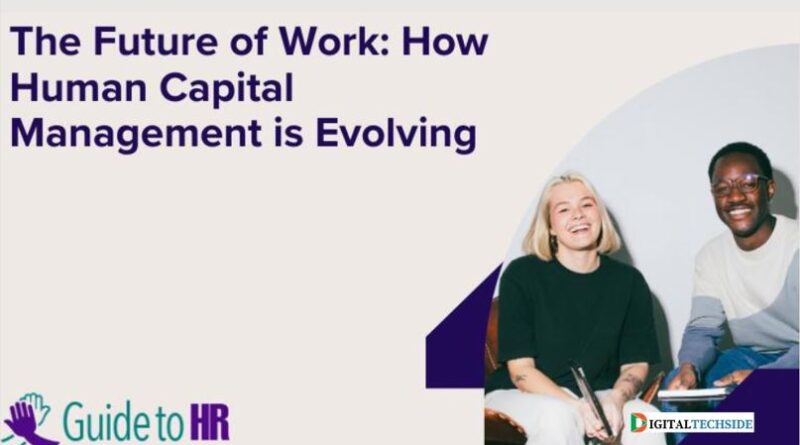The Future of Work: How Human Capital Management is Evolving
The world of work is undergoing a seismic shift. Technological advancements, a burgeoning gig economy, and evolving employee expectations regarding work-life balance are redefining the traditional workplace model. In this dynamic environment, Human Capital Management (HCM) practices need to adapt and evolve to attract, retain, and empower a future-ready workforce. This guide explores the transformative trends shaping HCM and how organizations can leverage them to thrive in the years to come.
The Future of Work Human Capital Management Landscape: Key Drivers of Change
Several key factors are propelling the transformation of the work landscape:
- Technological Advancements: Automation, artificial intelligence (AI), and cloud-based technologies are transforming the way we work. Jobs are being automated, while new roles are emerging that require different skillsets.
- The Rise of the Gig Economy: The gig economy allows individuals to work on a freelance or project basis, offering flexibility and independence, but often lacking traditional employee benefits.
- Shifting Workforce Demographics: Millennials and Gen Z constitute a significant portion of the workforce. These generations prioritize meaningful work, work-life balance, and continuous learning opportunities.
- The Great Resignation: Many employees are reevaluating their careers and priorities, leading to a surge in job changes and a tight labor market. Companies need to compete for talent with compelling HCM strategies.
Transformative Trends in Human Capital Management
To remain competitive and attract top talent in the future of work, organizations need to rethink their approach to human capital management. Here are some of the most prominent trends shaping evolving HCM practices:
-
The Rise of a Hybrid Work Model:
Remote work arrangements are no longer a perk but a necessity for many roles. A hybrid work model that combines remote work with occasional in-office collaboration is likely to become the norm. HCM practices need to adapt to support a geographically dispersed workforce. This includes investing in collaboration tools, establishing clear communication protocols, and fostering a strong remote work culture.
-
Focus on Employee Experience (EX):
Creating a positive and engaging employee experience is critical for attracting and retaining top talent. HCM strategies should prioritize employee well-being, offer opportunities for growth and development, and foster a sense of belonging and purpose. This may include providing flexible work arrangements, promoting work-life balance, and investing in employee wellness programs.
-
The Power of Data-Driven HCM:
HCM technology platforms are becoming increasingly sophisticated, offering data-driven insights to inform strategic HR decisions. These insights can help identify workforce trends, predict skills gaps, and optimize talent management practices. Leveraging people analytics can improve talent acquisition, performance management, and overall HCM effectiveness.
-
Upskilling and Reskilling for the Future:
Automation and technological advancements are constantly changing the skillsets needed for success. Organizations need to invest in upskilling and reskilling programs to equip their workforce with the skills necessary to thrive in the future of work. HCM strategies should focus on continuous learning and development, offering training programs, and encouraging employees to embrace new technologies.
-
Prioritizing Diversity, Equity, and Inclusion (DE&I):
A diverse and inclusive workforce fosters innovation, creativity, and improved decision-making. HCM practices should prioritize DE&I initiatives, attracting talent from diverse backgrounds, creating a fair and inclusive work environment, and closing the skills gap faced by underrepresented groups.
-
Talent Marketplace and Internal Mobility:
The future of work may see internal talent marketplaces emerge within organizations. These platforms would allow employees to easily find and apply for internal opportunities, fostering career growth and development. Additionally, promoting internal mobility can help retain talent and build a stronger internal talent pipeline.
-
Evolving Compensation and Benefits:
Traditional compensation and benefit packages may need to be restructured to reflect the changing needs of the future workforce. This may include offering flexible benefit options, remote work stipends, and tuition reimbursement programs to support continuous learning. Additionally, with the rise of the gig economy, organizations may need to explore alternative compensation models for non-traditional workers.
-
Focus on employee well-being:
Employee well-being has become a top priority in the future of work. HCM practices should go beyond traditional health insurance and encompass mental health resources, financial wellness programs, and flexible work arrangements to reduce stress and burnout. Additionally, promoting work-life balance can contribute to increased employee satisfaction and retention.
-
Building a Strong Employer Brand:
A strong employer brand that communicates an organization’s commitment to flexibility, learning and development, and employee well-being is crucial for attracting top talent in the future of work. Leveraging social media, career pages, and employee advocacy programs can help build a positive employer brand and showcase your company as a desirable place to work.
-
Building Trust and Transparency:
Trust and transparency play a key role in the future of work. Open communication between employees and management is essential for fostering a positive work environment and building trust. Organizations need to actively solicit employee feedback and regularly communicate about company goals, changes, and successes.
Embracing the Future of Human Capital Management
The future of work presents both challenges and opportunities for organizations. By embracing the transformative trends in Human Capital Management, organizations can:
- Attract and Retain Top Talent: Competitive HCM practices will help organizations compete for top talent in a tight labor market.
- Drive Employee Engagement and Productivity: Creating a positive employee experience and investing in employee well-being will lead to increased engagement and productivity.
- Embrace Change and Agility: HCM practices that promote continuous learning and development will enable organizations to adapt to rapid changes in the work landscape.
- Foster Innovation and Creativity: A diverse and inclusive workforce fostered by strong DE&I initiatives will drive innovation and creativity within organizations.
Building a Future-Proof HCM Strategy
Here are some key steps to build a future-proof HCM strategy:
- Conduct regular workforce planning to identify future skill needs and talent gaps.
- Invest in HCM technology platforms that offer data analytics capabilities and streamline HR processes.
- Foster a culture of continuous learning and development to equip your workforce with the skills needed for the future.
- Prioritize employee well-being and work-life balance to create a positive and engaging work environment.
- Build a strong employer brand that highlights your commitment to innovation, diversity, and employee growth.
Conclusion: HCM: The Key to Future Success
The future of work is evolving rapidly. Organizations that embrace transformative HCM practices and prioritize their human capital will be well-positioned to thrive in the years to come. By focusing on employee experience, upskilling your workforce, and building a culture of trust and transparency, you can.

As a DIGITALTECHSIDE author, the majority of our articles have been focused on technology, blogging, business, lifestyle, social media, web design and development, e-commerce, money, health, education, entertainment, SEO, travel, and sports.
Contact us at digitaltechside@gmail.com if you have questions of anything.




